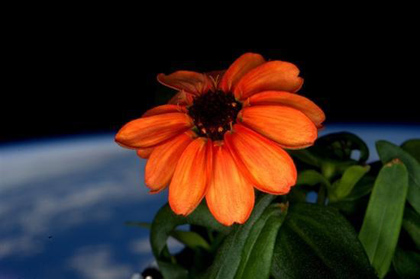In the popular sci-fi movie “The Martian”. The astronaut Mark Watney who was left behind on Mars rely on Mars planting potatoes to maintain the food supply, finally persevere until the support to the arrival of the rescue.
In reality, the research of how to grow plants in the space has been going. Recently, there has an significant progress, in the International Space Station for the first time in nurturing zinnia blossom and become the first flowers in space, the experiment will help to solve this NASA space food supply problems in manned voyage to Mars project.
This special Zinnia flower has similar shape and color compare with the flower in the planet, the growth cycle between 60-80 days. But because of the space station’s zero gravity state, they can not form petals on the earth like or graceful arc.
They are placed on an incubator called the “Veg-01 plant growth system” in cultivation. It is similar as lightbox in the same apparatus equipped with red, green and blue LED lights, let the plant to photosynthesis, and also designed with “plant pillow” to provide adequate nutrients to plant roots.
During the experiment, the Zinnia can not fully absorb moisture, moisture penetration out through the leaves, the worse the plants also signs of leaf curl up this “reverse” growth. The astronauts thought experiment failed at that moment.
Growth environment is too moist, the top of Zinnia seedlings grow mold on the bottom left corner of number E “plant pillow”.
To solve this problem, the astronauts put a small fan into the experiment. However, the effect of the fan was too strong, resulting in two zinnia seedlings deaths as dehydration. December 17, 2015, astronaut Scott Kelly tweeted that “our plant looks not very good, this is definitely a problem on Mars, and now must summon that Mark Watney up who in my heart.”
Scott Kelly’s action made sense, the remaining zinnia seedlings thrive in, then began to grow a little bud.
The bud slowly starts blooming, and finally the beautiful flowers come out. NASA scientists believe that Zinnia elegans is far different from the lettuce they planted before. Zinnia elegans is more sensitive to the environment and light, the growth cycle is longer,therefore it’s more difficult to cultivate.It is a very successful try planting zinnia plants under extreme conditions which helps astronauts a lot to explore the growth conditions of plants and nurturing more outer space plants in future.
In fact, as early as 1996, the Russian astronaut Shannon Lucid planted wheat in Soviet-built Mir space station, but if astronauts had tasted these crops is unknown yet.
In August 2015, astronaut Scott Kelly was taking a photo of himself and his second crop of Lettuce Lollarosso.
A few days later on August 10, 2015, Scott Kelly and his partners started eating the fresh “baked” lettuce leaves, first tasted the vegetables harvested in space.
Next, the astronauts plan to plant a series of other vegetables in the space station, and expect to cultivate tomatoes in 2018. After zinnia blossom, Scott Kelly took a picture of the flower in the sun against the background of the Earth. In any scenario, the plant will be an important part of human existence.

